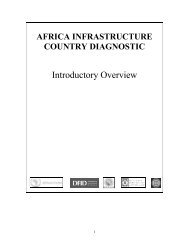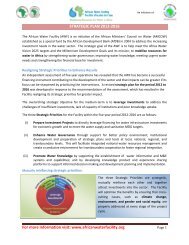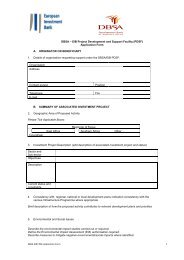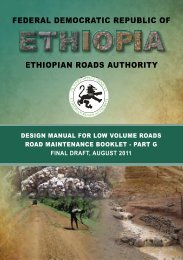Design-Manual-for-Low-Volume-Roads-Part-A
Design-Manual-for-Low-Volume-Roads-Part-A
Design-Manual-for-Low-Volume-Roads-Part-A
You also want an ePaper? Increase the reach of your titles
YUMPU automatically turns print PDFs into web optimized ePapers that Google loves.
A - Chapter 1 - 2<br />
work outside their normal areas of expertise and to understand implications of their recommendations or<br />
decisions on all other elements of the design.<br />
The successful design of low volume roads relies on:<br />
• A full understanding by the design engineer of the local environment (natural and social);<br />
• An ability to work within the demands of the local environment and to turn these to a design<br />
advantage;<br />
• Recognition and management of risk;<br />
• Innovative and flexible thinking through the application of appropriate engineering solutions<br />
rather than following traditional thinking related to road design;<br />
• A client who is open and responsive to innovation;<br />
• Guaranteed routine and periodic maintenance.<br />
There is an onus on the design engineer to provide a road that meets the expected level of service. <strong>Design</strong><br />
engineers are traditionally conservative and build in factors of safety that cater <strong>for</strong> their perceptions<br />
of risk and extremes of caution. This approach prevents the application of innovation, uses scarce or<br />
inappropriate resources and results in high financial costs <strong>for</strong> the client and the country. There is also<br />
often a temptation to provide or upgrade roads to a future level of service not justified by the economic<br />
or other project projections; or road user requirements. This type of approach absorbs available resources<br />
and prevents extension of access. It is the role of the design engineer to properly represent the clients<br />
and country’s interests.<br />
The level of attention and engineering judgement required <strong>for</strong> optimal provision of low volume roads is<br />
no different and in most cases is higher than that required <strong>for</strong> the provision of other roads. The design<br />
engineer needs to draw on all of his engineering skills, judgement and local experience if appropriate<br />
designs are to be developed without incurring unacceptable levels of risk. This manual will assist the<br />
engineer in that task.<br />
The <strong>Manual</strong> is fully compatible with the ERA Standard Specifications <strong>for</strong> Road Works, the ERA 2011 series<br />
of design manuals <strong>for</strong> higher volume road, and ERA’s Standard Bidding Documents.<br />
1.1 Road network classification<br />
The functional classification of roads in Ethiopia is based on five classes:<br />
• Trunk roads: roads linking Addis Ababa to centres of international importance and to international<br />
boundaries;<br />
• Link roads: connecting centres of national and international importance such as principal towns<br />
and urban centres;<br />
• Main access: connecting centres of provincial importance;<br />
• Collectors: connecting locally important centres to each other or to a more important centre or to<br />
a higher class road; and<br />
• Feeder roads: connecting minor centres such as a market to other parts of the network.<br />
<strong>Low</strong> volume roads can be represented in all five of these functional classes.<br />
<strong>Roads</strong> in Ethiopia can be further divided into three categories depending on ownership and the authority<br />
responsible <strong>for</strong> them. These are:<br />
• Federal (the responsibility of the Ethiopian <strong>Roads</strong> Authority);<br />
• Regional (the responsibility of the Regional or Rural <strong>Roads</strong> Authorities); and<br />
• Other rural roads (the responsibility of local authorities at Wereda or Kebele level or communities).<br />
ERA is responsible <strong>for</strong> major roads falling into the higher design classes, predominantly DC5 and above,<br />
but also has a substantial stock of roads below DC5. Regional and local authorities are responsible <strong>for</strong><br />
roads in classes DC4 – DC1.<br />
PART A: DESIGN STANDARD APPROACHES

















